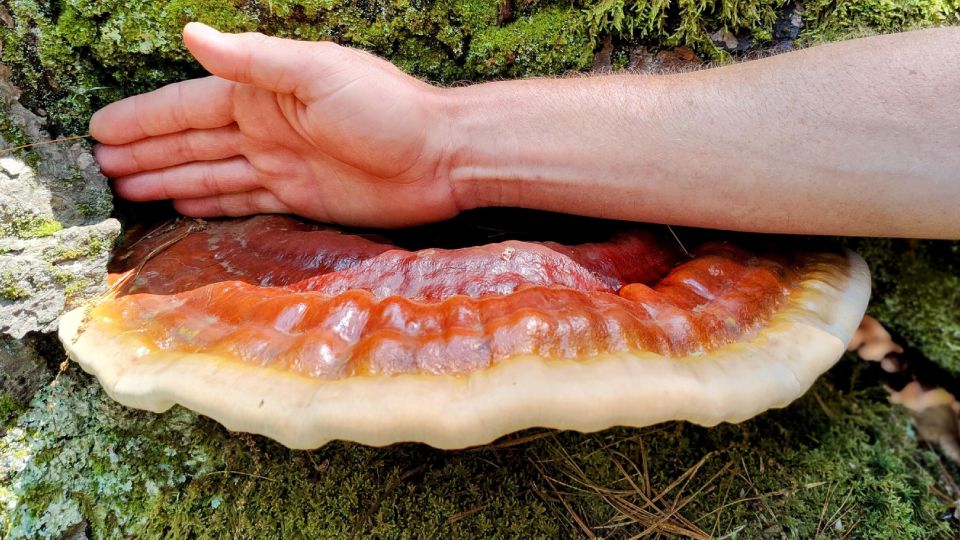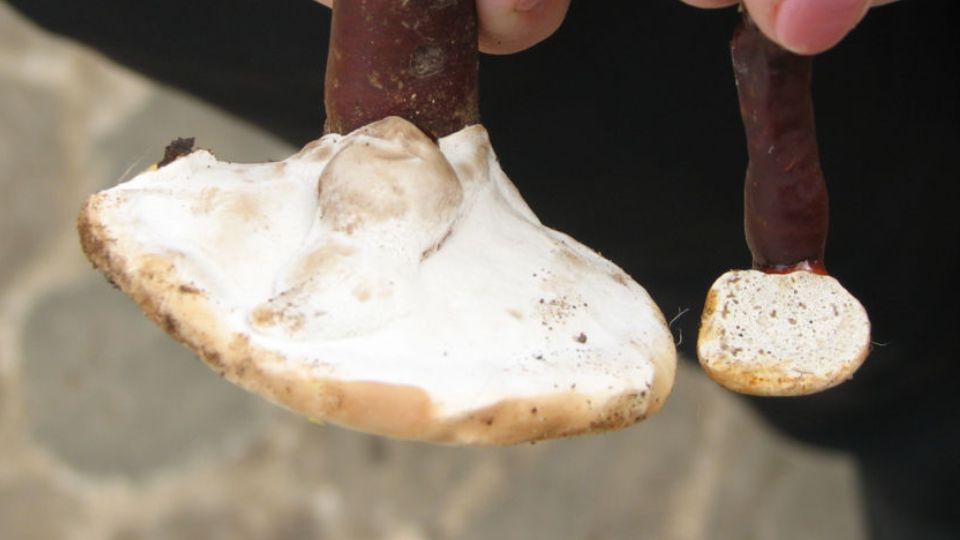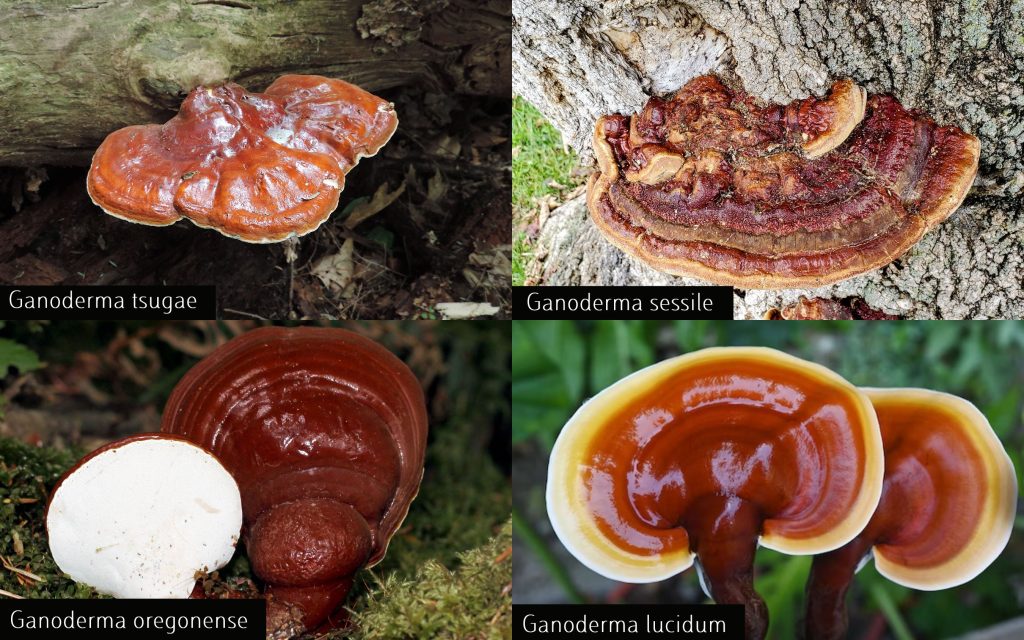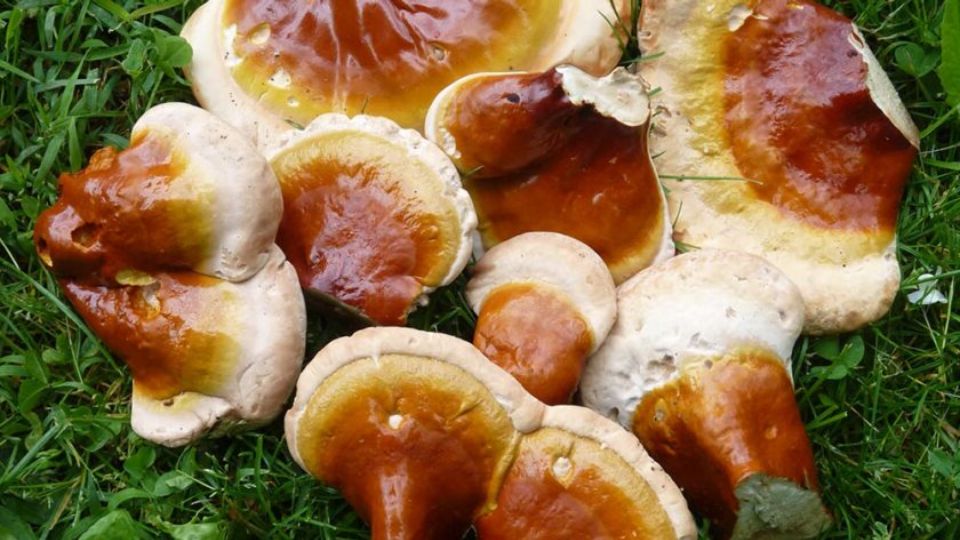Ganoderma Tsugae: Look-Alikes, Identification, And More
Ganoderma tsugae, like G. lucidum, is believed to have medicinal properties, especially in healing skin wounds. Scientists use phylogenetic analysis to distinguish closely related Ganoderma species, but they’re still debating which ones offer the most medicinal benefits. Variations within a species, its growth environment, the substrate it thrives on, and how it’s prepared all play significant roles in determining the medicinal value of the final product.
Recent studies have uncovered some seriously exciting stuff. We’re talking about antioxidant and anti-inflammatory powers, potential cognitive boosts, and even a potential cancer-fighting champion[1].
In this article:
What is Ganoderma Tsugae?

Ganoderma tsugae is known as “hemlock varnish shelf” or “hemlock reishi” because it prefers growing on hemlock trees. This mushroom is native to East Asia, specifically China, Japan, and Korea. With a reddish-brown or dark brown cap that can reach up to 30 centimeters in diameter, It has a unique appearance. Instead of gills, it has tiny pores underneath and a woody texture.
Traditional Asian medicine has highly esteemed them for their potential health benefits, considering them a symbol of longevity and vitality. Modern research has revealed several bioactive compounds in the mushroom, including polysaccharides, triterpenes, and antioxidants, which may contribute to its medicinal properties[2].
It’s important to remember that while G. tsugae holds promise, further scientific research is necessary to fully comprehend its effects and mechanisms of action.
Its History
Initially, the Ganoderma genus only included Ganoderma lucidum, also known as Reishi or Lingzhi. Recently, there’s been a detailed study on Ganoderma tsugae, focusing on its genome, evolution, substrate use, and terpene synthesis. The NCBI database categorizes organisms, including the widespread fungal genus Ganoderma, known for its harm to tree hosts, particularly in tropical and temperate regions.
In China, this fungus is widely cultivated for traditional Chinese medicine, sparking debates about its species. Detailed descriptions, illustrations, and talks about naming implications have surfaced. Suggestions include preserving the name Ganoderma lucidum for the Asian type and introducing a new name for the European species[3].
Ganoderma Tsugae Medicinal Properties

Many studies have delved into how the Hemlock Varnish Shelf mushroom can prevent and treat diseases, notably cancer. This mushroom shows impressive anticancer properties, making it a highly intriguing subject in scientific circles[4].
Here’s a table outlining the medicinal compounds found in G. tsugae:
| Medicinal Compounds | Description |
| Polysaccharides | Active compounds with demonstrated anti-tumor activity. |
| Triterpenes | Bioactive compounds present in G. tsugae. |
| Adenosine | A bioactive compound found in G. tsugae. |
| Small-molecule proteins | G. tsugae contains small-molecule proteins. |
The compounds in Ganoderma tsugae hold key medicinal properties that aid in wound healing and cognitive function. While the mushroom itself isn’t typically eaten due to its tough texture, you can still benefit from its health advantages by consuming teas or extracts made from its fruiting bodies. Consider trying these accessible forms if you’re seeking to heal wounds or boost cognitive function[5].
Laboratory and Preclinical Studies
Extensive lab and preclinical research has explored the benefits of G. tsugae, revealing its potential therapeutic applications and promising outcomes. Extracts from G. tsugae have shown antiviral and immunomodulatory properties, indicating they might boost your immune system and fight off viral infections.
Ganoderma Tsugae Benefits
Recent studies uncovered several health benefits linked to this mushroom. These include antioxidant, antibacterial, antitumor, hypoglycemic, and antithrombotic effects. For instance, one study showcased how G. tsugae prevents cognitive decline and lowers oxidative damage in the brain. Another highlighted the versatile properties of G. tsugae laccase (Lcc1), like breaking down lignin, promoting mycelium growth, elongating stipes, and producing pigments.
- Anti-tumor activity: The active polysaccharides in G. tsugae have shown the potential to fight tumors.
- Wound healing: It promotes wound healing in mice and has been used for dressing skin wounds[6].
- Cardiac protection: With its high antioxidant activity, It may shield your heart from stress-induced injury and reduce oxidative stress.
- Anti-cancer efficacy: Studies reveal that G. tsugae has the potential to combat metastatic prostate cancer cells, impede their growth, and induce apoptosis.
- Cognitive protection: Worried about cognitive decline? This mushroom has been found to prevent cognitive impairment and minimize oxidative damage in the aging rat brain.
While Ganoderma tsugae shows promise, more research is necessary to fully understand its effects and mechanisms. When considering any supplement or medicinal product, it’s wise to consult a healthcare professional before use.
Ganoderma Tsugae Look-Alikes

A comparative genomics study revealed that G. tsugae branched from a shared ancestor with G. lingzhi and G. sinense around 21 million years ago. Among the 80 known Ganoderma species, only a handful resemble G. tsugae.
G. lucidum stands out with its glossy reddish-brown cap and tough texture, typically thriving on hardwood trees like oak and maple worldwide, spanning Asia, North America, and Europe.
In eastern North America, you’ll find G. sessile on declining or dead hardwoods. Smaller in size, G. curtisii prefers deciduous trees compared to Ganoderma tsugae.
On the West Coast in places like the Pacific Northwest and California, G. oregonense thrives on conifer wood. It differs notably from G. tsugae—it’s larger, thicker, darker, and has bigger spores.
To summarize, among the known Ganoderma species, only Ganoderma lucidum, G. sessile, G. curtisii, and G. oregonense share certain similarities or characteristics with G. tsugae.
Edibility and Taste
You cannot eat Ganoderma lucidum due to its tough and corky texture. However, it is said that the fresh and soft edges of the mushroom can be sautéed and prepared in a similar way to the resinous polypore (Ischnoderma resinosum). Tho I haven’t personally tried this method myself, it could be worth experimenting with if you’re curious about exploring different culinary possibilities.
FAQs
How to Make Ganoderma Tsugae Tincture
To make Ganoderma tsugae tincture, gather dried G. tsugae mushrooms and alcohol, like vodka or grain alcohol. Grind the mushrooms, place them in a jar, cover with alcohol, and let it steep for several weeks. Strain the mixture and store the tincture in a dark bottle.
How to Distinguish Ganoderma lucidum From Ganoderma Tsugae
To distinguish Ganoderma lucidum from Ganoderma tsugae, observe their physical features. G. lucidum has a reddish-brown, glossy cap, while G. tsugae has a brownish cap with a white edge. Additionally, examine the spore color and consult a field guide for accurate identification.
How Late Can I Harvest Ganoderma Tsugae
You can harvest Ganoderma tsugae when the fruiting bodies are fully mature and have reached their maximum size. It’s best to harvest them before they start to deteriorate or show signs of decay.
How to Dry Ganoderma tsugae
To dry Ganoderma tsugae, gently clean off any dirt or debris from the mushrooms. Cut them into thin slices or small pieces for faster drying. Place the slices in a well-ventilated area or use a food/mushroom dehydrator at a low temperature until they become dry and crisp.
How to Prepare Tea From Ganoderma tsugae
To prepare Ganoderma tsugae tea, take dried G. tsugae slices and crush them into smaller pieces. Boil water and add the crushed mushrooms. Let it simmer for about 20 minutes. Strain the liquid and enjoy your flavorful and aromatic Ganoderma tsugae tea.
Conclusion
In conclusion, Ganoderma tsugae, the Hemlock Varnish Shelf mushroom, stands as a remarkable specimen in the world of medicinal mushrooms. Its taxonomy, medicinal properties, and potential benefits for preventing and treating diseases, including its anticancer properties, have piqued the interest of researchers. While laboratory and preclinical studies have shed light on its potential, further research is essential to unlock the full therapeutic potential of G. tsugae. Understanding its unique attributes and distinguishing it from similar species will aid in harnessing its benefits effectively.
References
1. Ganoderma tsugae extracts inhibit colorectal cancer cell growth via G2/M cell cycle arrest. Retrieved from https://www.researchgate.net/publication/23415238_Ganoderma_tsugae_extracts_inhibit_colorectal_cancer_cell_growth_via_G2M_cell_cycle_arrest
2. Lanostane triterpenoids from the medicinal mushroom Ganoderma tsugae. Retrieved from https://www.researchgate.net/publication/362812455_Lanostane_triterpenoids_from_the_medicinal_mushroom_Ganoderma_tsugae
3. Nutritional Profile and Health Benefits of Ganoderma lucidum “Lingzhi, Reishi, or Mannentake” as Functional Foods: Current Scenario and Future Perspectives. Retrieved from https://www.ncbi.nlm.nih.gov/pmc/articles/PMC8998036/
4. Antioxidant properties of methanolic extracts from Ganoderma tsugae. Retrieved from https://www.researchgate.net/publication/222078109_Antioxidant_properties_of_methanolic_extracts_from_Ganoderma_tsugae
5. Triterpenoids and an alkamide from Ganoderma tsugae. Retrieved from https://www.researchgate.net/publication/284233794_Triterpenoids_and_an_alkamide_from_Ganoderma_tsugae
6. An active ingredient isolated from Ganoderma lucidum promotes burn wound healing via TRPV1/SMAD signaling. Retrieved from https://www.researchgate.net/publication/361272546_An_active_ingredient_isolated_from_Ganoderma_lucidum_promotes_burn_wound_healing_via_TRPV1SMAD_signaling

